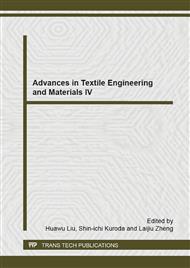p.9
p.13
p.17
p.21
p.26
p.31
p.36
p.41
p.46
Electric Field and Spinning Performance in Needleless Electrospinning
Abstract:
Different spinnerets can be used to generate needleless electrospinning with the potential to scale up the production of nanofibers. However, the electrospinning performance, normally refers to the quality of the as-spun fiber and the production rate, is dramatically different from different spinnerets. This study focuses on the electric field of different spinnerets under the same experimental parameters so as to understand the key factors that affect the electrospinning performance of upward needleless electrospinning. Modeling analysis suggested that the electric field could be further concentrated by optimizing the geometry of spinneret. Experimental investigation on needleless electrospinning from different spinnerets proved that the electrospinning performance was improved greatly with the optimization of the electric field of spinneret. Understanding of the relationship between electric field and spinning performance would benefit the design and development of needleless electrospinning.
Info:
Periodical:
Pages:
26-30
Citation:
Online since:
October 2014
Authors:
Price:
Сopyright:
© 2014 Trans Tech Publications Ltd. All Rights Reserved
Share:
Citation:


